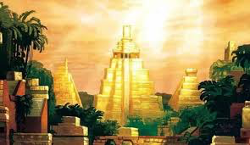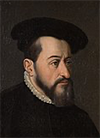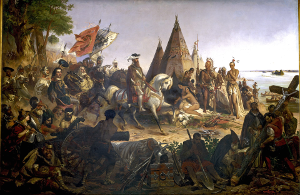Spain in the New World
Part 4: In the North By that time, Spanish exploration of the New World had progressed north from the Caribbean. In early 1513, a force under the command of Juan Ponce De Leon sailed for Bimini. They sailed for days but didn't see the island. On March 27, they came within sight of the Florida coast. On April 2, they landed at what he named St. Augustine. This became, in 1565, the first Spanish settlement on the mainland of North America. 
Other explorations sought out locations in Florida between the arrival of Juan Ponce De Leon and the founding of St. Augustine. An expedition led by Pánfilo de Nárvaez to Florida in 1528 ended in disaster; only four people of the original 600 survived the shipwreck and straggled into Mexico years later, after surviving a period of captivity in the hands of Native Americans. One of the things that kept these survivors going was the promise of the gold-laden Seven Cities that they had heard about along the way. One after another, expeditions to find the fabled Seven Cities of Gold set off. Among the most well-known of these was one of 1,700 men, led by Francisco Vásquez de Coronado. They set out from Compostela on Feb. 23, 1540 and went through what is now Arizona, Arkansas, Colorado, Kansas, Missouri, New Mexico, Oklahoma, and Texas. One contingent, led by Hernando de Alarcón, went via the Guadalupe River; Coronado led the other force, which traveled on land. They all found rumors but nothing more: Cíbola was nothing more than a normal settlement. Most of his force returned to Mexico in 1541; Coronado and a much smaller forced carried on, eventually returning empty-handed in 1542. Coronado claimed for Spain all of the land he explored. It was about the only benefit his explorations brought. Another well-known explorer, Hernando De Soto, was the first European to cross the Mississippi River. He had been a chief lieutenant of Pizarro's force that conquered the Inca and then had gone back north, serving as Governor of Cuba for a time before leading an expedition of 600 men through what is now the southeastern U.S. They traveled through what is now Alabama, Arkansas, Florida, Georgia, Louisiana, Mississippi, North Carolina, Oklahoma, South Carolina, Tennessee, and Texas. They crossed the Appalachian Mountains and Farther west went the explorer Juan Rodríguez Cabrillo, the first European to lead an expedition to explore what is now the west coast of the U.S. In 1542, his three ships and 200 men sailed up the Baja California coast, past what is today San Diego and going as far as what is today Monterey Bay. 
In 1535, the king established in Central America the Viceroyalty of New Spain, handing over authority to a person in residence. The first of many viceroys was Antonio de Mendoza y Pacheco (left). In the three centuries of New World rule, more than 70 served as viceroy; some served for only a few months, and the longest-serving (Mendoza) held the office for 15 years. The New World possessions were very far away from Spain, and viceroys enjoyed a large amount of autonomy. The Crown at times sent royal inspectors, some of whom traveled in secret, to check on the doings of a viceroy. The founding of Santa Fe came in 1610 as the result of actions by then-Governor Don Pedro de Peralta. A period of Spanish settlement ensued, punctuated by missionary efforts to convert the native peoples to Christianity, as elsewhere. Many of these native peoples didn't take kindly to such encroachment on what had been their homelands, and a large revolt led by Taos Pueblo occurred in 1680, resulting in a Spanish withdrawal south. Just a bit further west, Spain built more permanent settlements, including Tubac in 1752 and Tucson in 1776. Next page > Struggle for North America > Page 1, 2, 3, 4, 5, 6, 7 |
|
Social Studies for Kids
copyright 2002–2026
David White



 explored the Tennessee River Valley. They crossed the Mississippi River but didn't go up or down it. They, too, failed to find the Seven Cities of Gold.
explored the Tennessee River Valley. They crossed the Mississippi River but didn't go up or down it. They, too, failed to find the Seven Cities of Gold.
